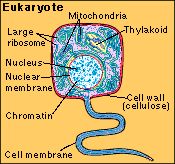Fossils and the history of life - What can the fossil record tell us about the origins of cells?

Eukaryotic cells
Unicellular prokaryotic life exists in the fossil record approximately 3.5 billion years ago. The other kind of cell, the eukaryotic cell, does not appear in the record until 1.8 billion years ago.
Eukaryotic cells are more complex, with a separate nucleus and organelles, and are usually larger than prokaryotic cells. The long time from the origin of life and of prokaryotic cells to the origin of eukaryotic cells - about 50% of biological history - suggests that it was an improbable, or evolutionarily difficult, transition.
There has been much research on the origin of organelles and it is widely (if not universally) accepted that they originated in a symbiotic union of ancestral prokaryotes. One cell may have entered another (wither as engulfed food, or as a parasite), and instead of being digested or parasitizing its host, it may have evolved into a symbiotic mitochondrion. (It is of course most unlikely that it was a unique event: rather, it would often occur that one cell entered another, and all sorts of evolutionary possibilities could ensue.) If the mitochondrial ancestor was originally a parasite, the theory about evolutionary increases and decreases in virulence gives reasons why it might have evolved into a symbiont.
Figure: all plants and animals are eukaryotic: they possess complex cells with a separate nucleus. Within the nucleus the DNA is here illustrated in the diffuse form called chromatin; when the cell divides, the chromatin coalesces into structures called chromosomes.
| Next |



